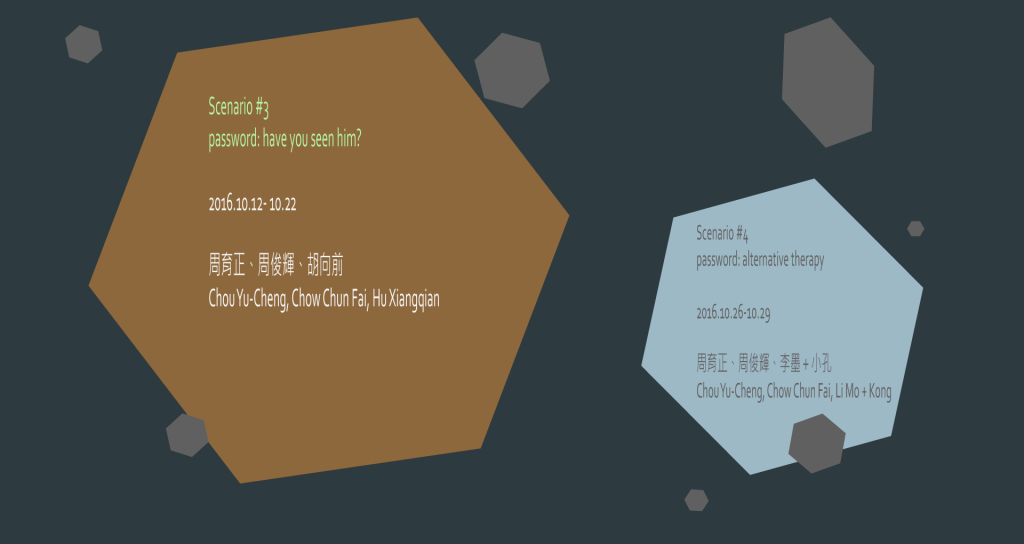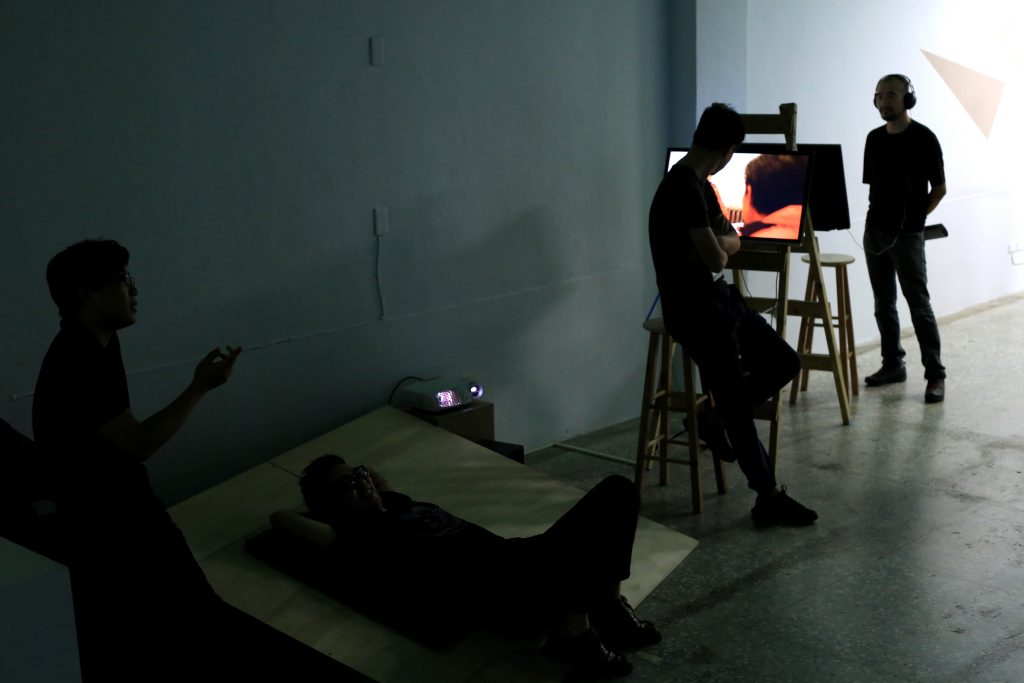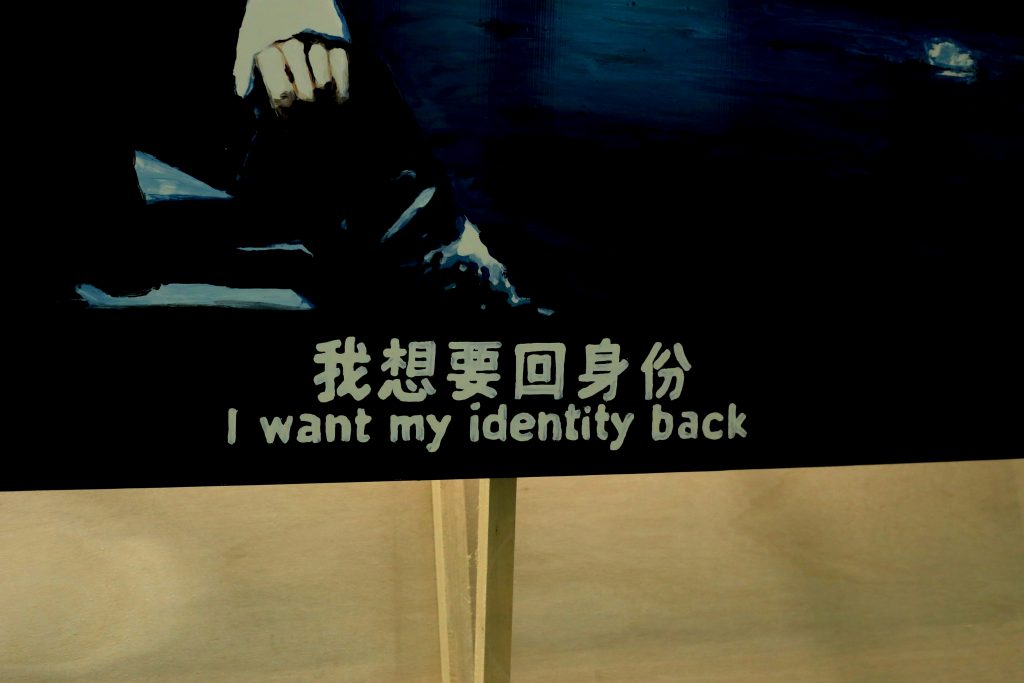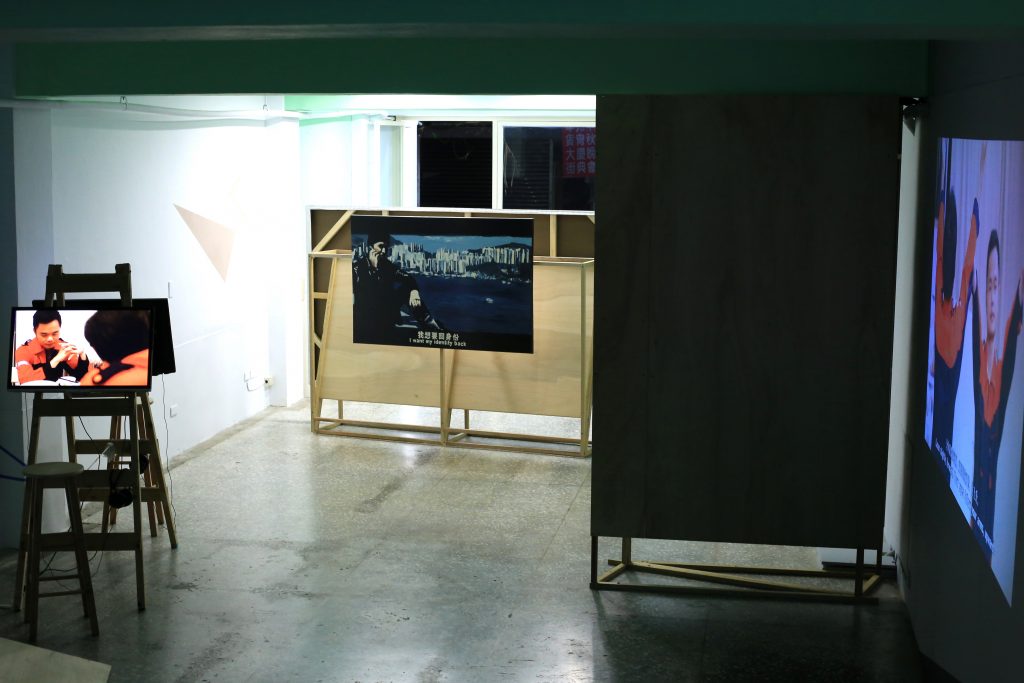For English, please scroll down.
此場景是關於默默無名者與匿名者的肖像/檔案,同時也是關於三種勞動生命的「典型」如何望向他方或跳脫的姿態,也就是關於如何成為一個能夠被命名之「人」。
周育正過去的作品,是關於藝術世界中既成之物(或為材料、工具、現成物、或另一位藝術家的作品)的調度,關於支撐體系如何被重新觀看、啟動而形成再利用的資本操作策略。在一系列《工作史-盧皆得》作品中,從對藝術勞動經濟的探討擴展至生命檔案的編繪,透過盧皆得先生——一位因為藝術臨時勞動而在場的生命個體——的生命展示,展覽介面是「如何成就生活」與「如何成為藝術」兩個問題的碰撞,關於「勞動生命如何被登錄」的過程。系列中《單色畫》是盧皆得先生臨時展場看顧工作的成果,所為勞動無它,只有留下繪畫的印跡。盧皆得身為臨時工的狀態,在台灣社會官僚制度重重限制下形同沒有法律保障的勞動流浪漢,他是那無時不刻移動在社會中、卻不被看見的芸芸眾生的一員。黑色單色繪畫的自動性、滿佈畫面、無止盡塗抹,所構成無色彩、無法辨識的畫面,如同拉岡談論的不可視性恰恰為無意識自身,顯示了台灣社會建基於無意識勞動為根底的精神結構。
匿名之徒並非沒有名字的人,相反地,因為某些特定的原由,被迫或主動放棄被書寫登錄的權利。如同電影《無間道》中——套用阿岡本的生命主權概念——臥底警察陳永仁被法律剝奪其成為正常公民的機會,其「人」的身份被法律覆蓋而成為當代的牲徒,他必須存活在法律無法保證生命的地帶,他的工作即是透過執行非法事件,同時冒著隨時被誤認、生命隨時被奪取的危險,以實現國家治理。這種生命的例外狀態當然直指九七後香港在一國兩制下的「懸置」,而今是否到了要回身份的關鍵時刻?抑或這種認同也永遠是一個擺盪的產物。
曾參與立法會功能組別選舉的周俊輝,作品一直都是對香港之生活-政治的一種表述。《無間道-我想要回身份》是周俊輝電影畫系列的代表性作品,這一系列作品所繪製的是一九八、九零年代的既成影像,透過呈現觀看捕捉香港的主體性。電影畫亦可被視為是運動中的截面,它跟隨的是香港認同意識組成的運動,一種香港式的影像-生命間密切的聯繫關係。周俊輝將我們停留在這畫格的凝視,也因為停格,一個開放的詮釋空間尚且保留,望向銅鑼灣的陳永仁可以有機會拿回他的身份;因為身為流動筆觸下的繪畫,陳永仁擁有著不必照劇本編寫而走的機會。
如同許多其他胡向前的作品一樣說著勞動者樣貌的可能性,《再造米開朗基羅》是關於一個意願成為藝術家的故事。主人翁邵振興向藝術家胡向前學習如何成為藝術家,藝術家以身、心、體修行的師徒傳授方式進行,他所有的學習除了一些藝術相關的經驗與少許抽象的概念,大體上是一個面對空無與自我懷疑的過程。邵振興在最後的表演中讓自己成為了米開朗基羅式的人物——米開朗基羅,那個是最早施展個體自主性的藝術勞動者,好似邵自此之後得以自主地雕塑自身的生命形象。這是一種啓蒙式的修練與試煉,而小紹處理自我展現的壓力以及必須與師承決裂的狀態,亦反映當代社會中個體與依據「展示慾望」所進行的敘事編寫的關係。
此三件作品形成相互凝望的姿態:三個故事主人翁,三個不被確保的生命,台、港、中三個地點形成的敘事迴圈繞經,成為我們的鏡像與凝結的迴圈。懸而未決,卻也銜在一種未知政治態勢的啟動點。
周育正
周育正關注在既有機制中生產另類的操作和思考邏輯,透過非典型合作的模式開發新型態的價値,並同時彰顯其相關之內在運作問題。近來的藝術計畫轉向於對生命的探討,將生命、藝術史、自傳等視為文本以探究現代性的翻轉和演繹工程,其處理美學和社會之雙面操作輕巧地展開在各種雕塑、繪畫、文學、劇場等多樣媒材空間裡。目前工作與生活於台北。
周俊輝
在周俊輝的創作之中往往可見其借助時空之差,以既隱晦卻深沈的政治寓意,賦予挪用的文本多重指涉。其作品往往跳出線性時間的直白描述,藉保有距離的觀看,以電影場景繪畫寄語朦朧及曖昧的側寫狀態,將對社會的共鳴及呈象現實宿命的糾結關係,以一股混入的「惡搞」氣質,從中笑謔世情謬事,作為一則則對於時下的即刻回應。目前工作與生活於香港。
胡向前
胡向前的行為表演以嘲諷荒誕的語法展開對於社會政治環境機制的批判,創造異質的日常領地,探尋自我存在之證據,其細膩精準的操作直逼表演和現實的臨界點,產生新的連貫性和互為後設的可能:表演性自身所載動的政治力量成為超越和啓發現實的途徑,幽默地取消了之間的疆界並展開重新凝視真實的條件。目前工作與生活於廣州與北京。
This scenario presents the portraits and archives of the nameless and anonymous, suggesting how three models of labor can escape their bio-political conditions. In other words, it is about how one could become a nameable individual.
Chou Yu-Cheng’s previous work tackles strategies of the redistribution of existing objects (such as materials, tools, readymade, or even another artist’s work) to discuss how to perceive and initiate an infrastructure, and then transform and reuse it as a new form of capital. In the series A Work History – Lu Chieh-Te, Chou attempts to illustrate the relation between the economics of artistic labor and bio-politics, by putting Lu on display. By highlighting an individual’s life through art, Chou’s exhibition asked two questions —“how to accomplish life?” and “how to become art?”. Ultimately it demonstrated the progression of a laborious life. Both an invisible and mobile laborer, Mr. Lu Chieh-Te constantly remains on shifting sands, as Taiwan offers no legitimate support or insurance for freelance workers. Mr. Lu’s sole production or trace, Monochrome, is a tip of the hat to his job as a temporary gallery guard. The black monochrome piece proves an unrecognizable, but autonomous composition without colors; harking back to the invisibility of the unconscious in Lacan’s terms. The painting can be seen as the manifestation of the psychological and unconscious social structure of labor in Taiwanese society.
An anonymous person is not a nameless one. On the contrary, he or she is either forced to or gives up their identity. We can then see the Hong Kong film Internal Affairs as an example of relinquishing one’s identity for the good of the state, borrowing Giorgio Agamben’s argument for sovereignty and life in our analysis of its lead character. Undercover police officer Chen Wing-yan is stripped of his rights to live as a normal citizen in order to carry out illegal yet government sanctioned assignments. Deprived of his individual identity he is forced to live as Agamben’s homo sacer (accursed man). The film’s setting certainly reflects the suspended political condition in Hong Kong after 1997 and asks: Has the critical moment to reclaim identity arrived? Or will identity always be subject to political motions?
The artist Chow Chun Fai, who participated in the legislative council election in Hong Kong, has been working to transcribe the relation between life and politics within the local context. Infernal Affairs, “I Want My Identity Back” is one of Chow’s movie painting series, which depict HK film stills from the 80s and 90s to reveal the subjectivity of collective seeing. The film painting might be considered a slice of a motion running parallel with the HK consciousness, or perhaps as a bridge that connects HK style, image, and life. Chow allows us to hold a gaze on this cinematic still to reserve a new and open interpretation for this single frame. Perhaps Chen Wing-yan will have a chance to reclaim his lost identity, not following the film script, and instead being driven by the flowing brush.
Hu Xiangqian’s many projects address the possible expressions of labor. Reconstructing Michelangelo is a story about the willingness to become an artist. The protagonist Shao Zhenxing is an apprentice under the artist Hu Xiangqian, who conducts his artistic practices of body, mind and spirit to set on a journey that confronts emptiness and self questioning, while sharing abstract ideas for art and art related experiences. In the final performance, Shao Zhenxing attempts to be a Michelangelo-style character, a symbol for the first identifiable art laborer, which allows him to begin shaping his image of life. It is a test through the process of enlightenment. The pressure that Shao dealt with for the sake of self-exhibiting, and in separating himself from his master, further reflects the narrative of people exhibiting autonomous aspirations in contemporary group-think culture.
These three works of art gaze upon one another: three protagonists, three uncertain lives from Taiwan, Hong Kong and China compose a circulating narrative and create our mirror images that are frozen and suspended, as the scenario attempts to connect with new agencies in the unknown political climate.
These three works of art gaze upon one another: three protagonists, three uncertain lives from Taiwan, Hong Kong and China compose a circulative narrative and create our mirror images that are frozen and suspended, as the scenario attempts to connect with new agencies in the unknown political climate.
CHOU Yu-Cheng
CHOU Yu-Cheng creates alternative modes of operation and contemplation within existing mechanisms to expose implicit problems and create new sets of exchange value through unconventional collaborative models. His recent projects uses life experience, art history and biography as his subject to create an interplay between aesthetics and society to investigate the transformation and interpretation of modernity through a variety of media including sculpture, painting, literature and theatre. Chou lives and works in Taipei.
CHOW Chun Fai
In the temporal gap between the production and reception, CHOW Chun Fai’s nonlinear narratives are imbued with hidden yet intense political expression. His often humorous paintings drawn from cinema represent the vague and ambiguous social conditions of class and Status as a dilemma in reality. Chow lives and works in Hong Kong.
HU Xiangqian
HU Xiangqian is known for performances that create unusual everyday situations. Through a theatre of the absurd he directs the evidence of existence as a critical act directed towards social and political institutions. Through a precise and sophisticated manipulation of the boundary between performance and reality he creates new contiguities and self-reflections. The political power of his work is based in these short circuits that invalidate the limitations of perception. Hu lives and works in Guangzhou and Beijing.




